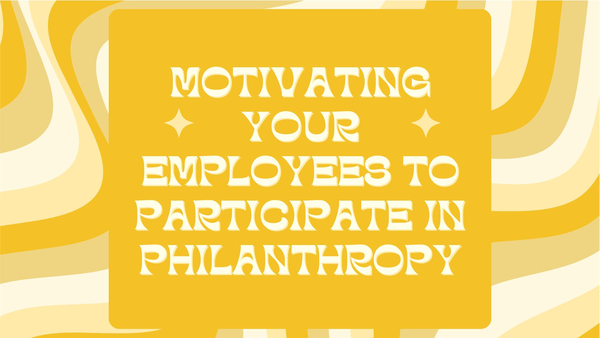Motivating Your Employees to Participate in Philanthropy

Motivating Your Employees to Participate in Philanthropy
Importance of employee engagement in philanthropy
Employee engagement in philanthropy is crucial for both nonprofit organizations and for-profit businesses. Engaged employees are more likely to support charitable initiatives, whether through donations, volunteer work, or fundraising efforts. This increased involvement can lead to greater resources and support for nonprofit organizations, ultimately helping them better fulfill their mission.
For for-profit businesses, promoting employee engagement in philanthropy can enhance their corporate social responsibility efforts, improve their company's reputation, and attract socially conscious consumers. Additionally, engaged employees are more likely to feel a sense of pride and fulfillment in their work, leading to increased productivity and retention.
The impact of engaged employees on the success of philanthropic initiatives is significant. Employees who are passionate about a cause are more likely to actively promote and participate in fundraising events, volunteer programs, and other charitable activities. Their enthusiasm can also inspire their colleagues and even encourage leadership to get involved, leading to a culture of giving within the organization.

Benefits of corporate giving programs
Corporate giving programs provide businesses with the opportunity to make a positive impact on the community while also benefiting the company itself. These programs allow businesses to support causes that align with their values and mission, while also boosting employee engagement and morale. Additionally, corporate giving programs can enhance the company's brand and reputation, strengthen relationships with customers and clients, and even attract and retain top talent. Overall, these programs not only benefit the community and those in need, but also have numerous advantages for the business itself.
Creating a Culture of Giving
Creating a culture of workplace giving within companies comes with numerous benefits. Research shows that employees desire to be involved in charitable activities, and workplace giving provides an avenue for fulfilling that desire. Moreover, fostering a culture of giving can boost morale, enhance team cohesion, and ultimately improve employee engagement.
To promote workplace giving, it is important for organizations to strike up a relationship with businesses that have established workplace philanthropy programs. This can provide opportunities for team members to volunteer, donate, and participate in charitable activities. By partnering with businesses, companies can also gain access to resources and support to make their workplace giving initiatives more effective and impactful.
Encouraging employee involvement in company philanthropy programs not only benefits the community but also yields positive outcomes for the company itself. In addition to creating a positive work environment, workplace giving can enhance the company's reputation and attract potential employees who value corporate social responsibility. Building a culture of giving within a company not only benefits the community but also enriches the workplace experience for employees.

Role of company culture in promoting philanthropy
Company culture plays a crucial role in promoting philanthropy within an organization. By fostering a sense of purpose and commitment among employees, company culture can inspire individuals to give back to the community and make a positive impact. This can be achieved by integrating philanthropy into the company's values and mission, creating a strong sense of social responsibility among employees.
Furthermore, a strong company culture that encourages philanthropy provides opportunities for volunteerism and community engagement. This can lead to increased employee engagement, as individuals feel connected to the company's values and motivated to contribute to meaningful causes. Employees who are given the chance to give back often experience a sense of fulfillment and purpose, leading to higher motivation and a positive impact on employee productivity.
Ultimately, by promoting a culture of philanthropy, companies can create a more engaged and motivated workforce, while also making a significant impact on the community. This aligns with the idea that businesses have a responsibility to give back to society, creating a win-win situation for both the company and its employees.
Fostering a sense of purpose and social responsibility among employees
In today's increasingly interconnected and socially conscious world, fostering a sense of purpose and social responsibility among employees is becoming a vital aspect of HR and management. By promoting a culture of purpose and social responsibility, organizations can not only enhance employee engagement and satisfaction, but also contribute to positive social and environmental impacts. This can manifest in various ways, such as encouraging volunteerism, supporting charitable initiatives, and promoting sustainable business practices. In this article, we will explore strategies and best practices for fostering a sense of purpose and social responsibility among employees, and how doing so can benefit both the employees and the organization as a whole.
Communicating the Impact
Employee giving participation can have a significant impact on causes that employees care about. By sharing success stories of how employee giving has made a real difference, employees can see the tangible effects of their contributions. Highlighting the company's matching gift ratio can also motivate employees to participate, as it amplifies the impact of their donations.
Furthermore, recognizing employees for their participation can enhance morale and further incentivize others to get involved. Using a fundraising thermometer can visually represent progress towards a goal, creating a sense of momentum and excitement around the campaign.
By employing these methods, employees can see the real difference their participation can make on causes they care about. From seeing success stories to understanding the company's commitment to matching their donations and being recognized for their efforts, employees can gain a deeper understanding of how their contributions are driving positive change in the community. These communication strategies can foster a sense of pride and purpose among employees, driving greater engagement and participation in employee giving initiatives.

Highlighting the difference their participation can make
Encouraging individuals to get involved in various initiatives, whether it be volunteering, charitable giving, or advocacy, can make a significant difference in creating positive change in their communities and the world at large. Highlighting the impact of their participation can inspire more people to take action and contribute to meaningful causes. By showcasing the difference their involvement can make, individuals can see the real and tangible effects of their efforts, which in turn can motivate them to become more actively engaged in making a difference. Whether it's through donating their time, skills, or resources, people who realize the impact of their participation are more likely to continue to support and promote causes that are important to them. By highlighting the difference their participation can make, individuals are empowered to become catalysts for change and drive positive outcomes in their communities and beyond.
Providing Options for Involvement
To provide a range of options for involvement, organizations can offer a variety of volunteer opportunities to cater to different interests and capabilities. This can include traditional in-person volunteering, remote volunteer opportunities, skills-based volunteering, and even virtual volunteering. Additionally, enabling multiple giving options like matching gifts, volunteer grants, and cause cards can encourage employees to support causes they are passionate about. Matching gifts allow employees to double their impact by matching their charitable donations, while volunteer grants provide financial support to nonprofit organizations where employees volunteer their time. Cause cards can also be provided to employees as a way to make charitable donations to their chosen causes.
Expanding giving programs to include employees' dependents and customers can also increase involvement and engagement. This could involve allowing employees to allocate a portion of their giving funds to a cause chosen by their dependents, as well as providing customers with the opportunity to support causes through their purchases or interactions with the company.
Incorporating a giving hub can further promote employee engagement and make it easy for individuals to give to causes that matter to them. This centralized platform can provide information on volunteer opportunities, giving options, and resources for employees to learn about and support various causes. By offering a range of options for involvement, organizations can better engage their employees and create a positive impact on their communities.
Encouraging employees to choose causes close to their hearts
Empowering employees to support causes they are passionate about can lead to a more engaged and motivated workforce. By allowing them the freedom to make a difference in areas that hold personal significance, employers can not only demonstrate their support for their staff but also show a commitment to making a positive impact in the community. Encouraging employees to choose causes close to their hearts can also foster a sense of purpose and fulfillment, as they are able to align their personal values with the values of the organization they work for. Furthermore, promoting a culture of giving back can enhance the company's reputation and attract like-minded individuals who are attracted to the idea of working for an organization that values and supports corporate social responsibility. Overall, offering employees the opportunity to support causes they believe in can lead to a more cohesive and socially responsible workplace.
Employee Buy-In and Engagement
Employee buy-in and engagement are essential to driving organizational success. When employees are fully committed and invested in their work, they are more likely to go the extra mile, contribute innovative ideas, and deliver high-quality results. This leads to improved business performance, increased retention rates, enhanced safety, reduced absenteeism, and stronger customer relationships.
To foster a culture of engagement in the workplace, organizations can implement strategies such as open communication, regular feedback, recognition and rewards programs, opportunities for professional development, and a supportive and inclusive work environment. Involving employees in decision-making processes and encouraging collaboration also helps to enhance their sense of ownership and engagement. Engaged employees tend to be more loyal, motivated, and productive, which ultimately benefits the organization in terms of reduced turnover costs, improved safety records, and increased customer satisfaction. By prioritizing employee buy-in and engagement, organizations can create a positive, high-performing work culture that drives success on all fronts.

Involving employees in decision-making processes related to philanthropic initiatives
Involving employees in decision-making processes related to philanthropic initiatives is crucial for fostering employee engagement and motivation. When employees have a say in the charitable activities their organization supports, they feel a stronger sense of connection and purpose. This involvement can lead to increased employee morale and loyalty, as they see the company as aligned with their values and priorities.
Employees can contribute to decision-making by voting on charitable initiatives, where they can choose which causes the company should support. Additionally, they can participate in volunteer project selection, allowing them to have a direct impact on the community and causes they are passionate about. Empowering employees to have a voice in the organization's philanthropic efforts not only increases their sense of ownership and pride but also drives a greater impact in the community.
By incorporating employee input into philanthropic decision-making, organizations can cultivate a more inclusive and engaged workforce. This strategy not only benefits the community but also plays a pivotal role in enhancing employee empowerment and overall organizational culture.
Creating opportunities for open dialogue and feedback
Encouraging open dialogue and feedback is essential for fostering a healthy and productive work environment. One way to do this is by holding regular town hall meetings where employees can openly express their thoughts, concerns, and ideas. Additionally, implementing anonymous suggestion boxes allows employees to provide feedback without fear of repercussions. Team huddles provide an opportunity for open dialogue within smaller groups, fostering more intimate conversations. One-on-one meetings with managers also offer a chance for employees to express their thoughts in a more private setting. Utilizing employee surveys is another effective way to gather feedback and gauge overall employee satisfaction.
In order to encourage open and honest communication, it is important to create a culture of psychological safety where employees feel comfortable sharing their opinions without fear of judgment. Actively listening to employee feedback and demonstrating that their input is valued is also crucial. Furthermore, incorporating the feedback received into decision-making processes and communicating the actions taken based on employee input is essential for demonstrating the value placed on their feedback. By consistently providing opportunities for open dialogue and feedback, and actively listening to and acting on employee input, a positive and collaborative work environment can be cultivated.

Maximize Your CSR and Social Impact Programs
DonationXchange robust philanthropy management software helps you streamline administrative tasks and maximize the impact of your donation dollars!
Watch the video:
How DonationXchange Can Help:
• Create & Track Fundraisers, Scholarships, Grants & More!
• Manage & Grow Donor Base
• Process, Track, and Analyze Donation Requests
• Manage Volunteer Opportunities
• Supercharge Employee Engagement
• Champion the Causes that Matter to YOU!
Schedule a demo today!